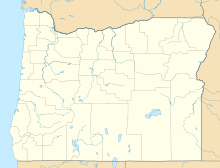Paisley caves

Coordinates: 42 ° 45 ′ 41.9 ″ N , 120 ° 33 ′ 13.2 ″ W.
The Paisley Caves (English "Paisley Caves" or "Paisley Five Mile Point Caves" or "Paisley 5 Mile Point Caves") are eight caves and abrises in the basin of Summer Lake 8 km (5 miles) north of Paisley , Lake County in the US state of Oregon . Archaeological finds in the caves from the years 2002/03, which were analyzed in 2007 and published in 2008, confirm the theses about the beginning of the settlement of America , but push the beginning around 1500 years before the previously assumed date. They are evidence of pre-clovis Paleo Indians . In 2011, the known period for the colonization of America was pushed forward by finds in the Buttermilk Creek Complex in Texas , which are dated to 15,500 to 12,300 years BP .
Excavations
Luther Sheeleigh Cressman first excavated the Paisley Caves in 1938 . Human and animal bones, tools and fireplaces were found.
The caves were created by the waves of the prehistoric Lake Chewaucan , which covered large parts of central Oregon at the end of the last Ice Age and from which today's Summer Lake emerged . When the lake's water level fell considerably after the Ice Age, silt and sand as well as fine debris were carried into the caves by the wind. Organic material such as bones, excrement , plant parts and artifacts were brought in by humans and animals. Among the artefacts made of organic material, cords made of animal tendons and plant fibers, animal fur, wickerwork and wooden pegs could be found. Due to the extremely dry climate of the region, the organic components have remained in an excellent state of conservation. In addition, a few stone tools and cuts from the manufacture of stone blades were discovered. The stratigraphy was undisturbed and was dated using traditional methods to the transition period between the Pleistocene and Holocene .
The University of Oregon has been using the cave for educational excavations since 2002 . During the excavations in the winter of 2002/03, 14 coprolites were found in the lowest layers , which come from human feces from an early settlement of the cave. According to calibrated 14 C data, the excrement is around 14,300 years old. Human DNA could be identified in the finds in 2008 . The mitochondrial DNA was able to study at the University of Copenhagen - with confirmation by the University of Leipzig , and University of Uppsala - the Haplogroups A2 and B2 are assigned, to the Indian belongs Native Americans. A contamination of the finds by the excavators was ruled out because none of them bear the specific genetic characteristics of the native Indian population. A transfer of the DNA from higher, younger layers could also be ruled out because the coprolites lacked the DNA of the desert bush rat ( Neotoma lepida ), which is widespread in younger layers.
The age of the finds is at least 1000 years before the archaeological evidence of the Clovis culture , which is considered to be the earliest human culture in America. The existence of Pre-Clovis (before Clovis) Paleo-Indians has been considered a scientific doctrine since about 2000 , but no directly dated human remains were available until the publication of the finds from the Paisley Caves. The findings from Oregon also fit locally into the assumed settlement development. Accordingly, the first inhabitants of America came at the end of the last ice age over the Beringia land bridge that still exists between Siberia and Alaska. The findings in Oregon suggest that they moved south on the Pacific coast and did not take advantage of an ice-free gap between the Laurentide Ice Sheet and the glaciers of the Coast Mountains in northern Canada's Yukon Territory , as was alternatively assumed .
The oldest clearly identifiable tool marks have also been found in the Paisly Caves. One bone each from a mountain goat and an ungulate animal that cannot be identified more precisely show cutting marks that come from a stone tool. The bones were dated to 13,688 and 14,933 Before Present and are thus 700 to 1500 years before Clovis and match the coprolite finds.
Web links
- Supporting online material for the science articles , genetic analyzes, description of the methods and detailed results (PDF; 1.10 MB; English)
Individual evidence
- ↑ a b University of Oregon: NGBPP Research at the Paisley Caves ( Memento of the original from February 18, 2012 in the Internet Archive ) Info: The archive link was inserted automatically and has not yet been checked. Please check the original and archive link according to the instructions and then remove this notice. (English)
- ↑ Insightful legacies. In: Wissenschaft.de. April 4, 2008, accessed September 8, 2019 .
- ^ Pre-Clovis Breakthrough , April 3, 2008.
- ↑ M. Thomas P. Gilbert, L. Jeninks et al .: DNA from Pre-Clovis Human Coprolites in Oregon, North America . In: Science , May 9, 2008, Vol. 320, pp. 786-789, doi : 10.1126 / science.1154116 (English).
- ^ The Clovis First Theory is put to rest at Paisley Caves , Heritage Daily, July 12, 2012, accessed July 14, 2012.
- ↑ Michael Balter: DNA from Fossil Feces Breaks Clovis Barrier . In: Science , Vol. 320, April 4, 2008, p. 37 (English).
- ^ Bryan Hockett, Dennis L. Jenkins: Identifying Stone Tool Cut Marks and the Pre-Clovis Occupation of the Paisley Caves . In: American Antiquity , Vol. 78, No. 4, October 2013, pp. 762-778 (English).
